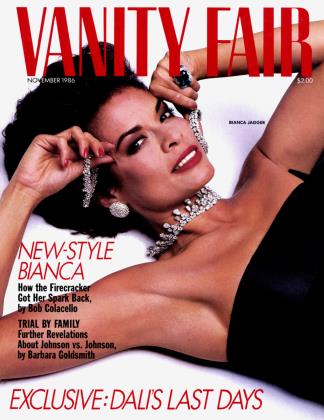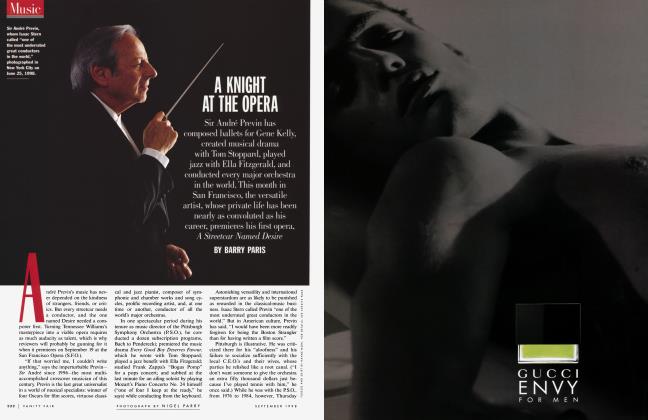Sign In to Your Account
Subscribers have complete access to the archive.
Sign In Not a Subscriber?Join NowSex and Drugs and Folderol
JAMES WOLCOTT
JAMES WOLCOTT on Gelsey Kirkland's tutu shocking memoirs
Hot Type
When football players began publishing badass exposes back in the early seventies about life down in the gladiator pit (my cleats in your face, that was the general attitude), the critic Wilfrid Sheed proclaimed that the literature of nausea had come to pro sport. With Gelsey Kirkland's Dancing on My Grave (Doubleday), the literature of nausea has finally muscled up to the barre to confront ballet. Instead of "1 Was a Vampire for the Chicago Bears" (Sheed's joke), it's "I Was a Dancing Skeleton for George Balanchine." Cowritten with her husband, Greg Lawrence (whom she met during an attempted drug buy), Kirkland's book is a pipe bomb of gossip. Balanchine's haughty reserve and roving eye; the love affairs with glamorous dance partners Peter Martins and Mikhail Baryshnikov; the revenge of ballerina Heather Watts, a love rival (''Oh, Gelsey, do you know what Peter said to me... ? He told me that making love to you was like masturbating"); the coke; the crippling injuries—it's all here, complete with color commentary by dance's most impish comedienne, Natalia Makarova. ''Sooo ... Gilzey... vhut is this I hear about you and Peter Martins? Vhut! You just take men... pick up... and poof.
But if Kirkland is indiscreet (and is she ever!), her aspirations are visionaryascetic. Dancing on My Grave may be dance's nuttiest contribution to the annals of maniacal devotion since Nijinsky's diary. Where Nijinsky jumped through hoops of madness, Kirkland fords streams of delirium in her pursuit of pure airy sylph perfection. To etherealize herself, she removes her skin, as if to become sheer moving thought.
Father doesn't know best is the book's flogged theme. Kirkland's own father was a stage and screen writer who was twenty years older than Kirkland's mother, and fading fast (''He had had five marriages and five heart attacks"), his skid accelerated by alcohol. _
He was among the first adults Gelsey tried to set straight. Scolding a grownup family friend for repeating himself, three-year-old Gelsey says with a lisp, ''You thet it, and you thet it, and you thet it... and don't thay it again." That pretty much establish_ es the pattern for Dancing on My Grave, an extended brat attack in which Gelsey lectures every tottering elder living and dead who conspired to bury her blaze under a gray ash (including, in one fell swoop, Balanchine, Stravinsky, and Chagall—a gang-up of three Russian men on one American girl, claims she).
Kirkland doesn't spare herself the lash. A self-described pudgeball, the former star of the New York City Ballet and American Ballet Theatre honed her craft as a hunger artist at the School of American Ballet, where Balanchine dictated a lean-cuisine look for his precision instruments. ''With his knuckles, he thumped on my sternum and down my rib cage, clucking his tongue and remarking, 'Must see the bones.' " His company became a pasha's dream of bony delights, a veritable harem of thinny-thins. ''Sooo skeeeny!" exclaims Makarova when she sees Kirkland after class, and it's small wonder Gilzey was sooo skeeeny. She downed emetics to induce vomiting and, more exotically, took injections of pregnantcow's urine, touted as a miracle diet aid. Injured, she subsists on a meal consisting of a slice of green apple and a dab of cottage cheese.
If Kirkland had stuck to starvation, her book might have been simply another no-cal vigil, like so many of the books by former N.Y.C.B. dancers— fond, wistful, slight. But Kirkland is a true obsessive—a pain demon. She went beyond starvation into mutilation. She had breast implants, silicone shots in her ankles and lips, even a surgical snip of her earlobes. (The reactions of her boyfriends ranged from puzzled to relieved. When Kirkland stammers out the truth to one beau about her breast-enhancement operation, he says, "Is that all? I thought you were going to tell me you were a transsexual.") Cocaine became a logical extension of her make-over obsession because it both kept her tension-trim and gave her a reckless buzz of energy. So reckless that she even took up with a drug dealer who wooed her by asking, "Have you ever had coke up your ass?" (Is this the place to note that the book's editor is Jacqueline Kennedy Onassis? I guess not.) Circuit overload isn't long in coming. In the Met cafeteria she has a brain seizure that flips her backward in the air and splits her scalp. She was, as the druggies say, struck by skull lightning.
She downed emetics to induce vomiting and, more exotically,; took injections of pregnant-cow9s urine, touted as a miracle diet aid.
It's amazing that Kirkland has been able to rise from her own smoking heap. Few survive an auto-da-fe of their own making. (She's even survived as a dancer, doing Romeo and Juliet to large acclaim last spring at Covent Garden.) Whether she should have turned her private burning into public spectacle is a tough call to make. Balanchine the creator is beyond mortal fuss (masterpieces such as Serenade and Symphony in C are scandalproof), but there's no question that her book besmirches Balanchine the man. He's the enthroned deity, the big papa she means to topple. She portrays him as a sad, aging sugar daddy playing Flavor of the Month with N.Y.C.B.'s female corps. "A certain dancer might receive a refrigerator or a more practical gift if she allowed his fondling touch in private." What could be more practical than a refrigerator?—a blender? a toaster? The point is, the image of Balanchine trading small appliances for a little touchy-feelie strains credulity. Kirkland is at her most cuckoo when it comes to Balanchine, not only accusing him of minor infractions but denying that he was ever majestic in his art or person. To her he's a petty despot, dotty and vain. Although she eventually grudgingly admits that there might have been something to his advice to stop thinking and do the steps, she never quite shakes off her pint-size perspective. The dapper, brooding, solar-polar spirit which imbues Robert Maiorano and Valerie Brooks's Balanchine's Mozartiana: The Making of a Masterpiece (Freundlich Books, 1985) is nowhere in these pages.
Mercifully, Balanchine himself isn't present to read her hurtful words. But Mikhail Baryshnikov and Peter Martins are. Considering what an unholy handful Kirkland was, Martins and Misha emerge as princes of doleful countenance, although they won't feel very princely seeing themselves traipsing through Kirkland's life in their birthday suits, no matter how Greek-godlike their builds. It's a cold indignity, being turned into a naked statue.
Gauche as Dancing on My Grave sometimes is, however, it does offer a 3-D glimpse into the mind-body battlefield of a great dancer's career which is unsurpassed. The cool transparency of Kirkland's immaculate dancing took a lot of fanatical polishing. (Not to mention some daffy fieldwork. To prepare for Jerome Robbins's The Cage, she studied the to-and-fro of cockroaches: "My insect had to mesh with the choreographical web that Robbins had in mind.") Whether Kirkland is laboring under a red-and-gold contraption of a costume in The Firebird or locating the motive behind the movement of Kitri's fouett^s in Don Quixote or searching for an "inward rotation" within the rapt stillness of La Bayadere, she seems to be reliving a stress test on a lit stage inside her own head. She can even be slapstick: "See ya later," she says sotto voce to her doomed lover at the end of Swan Lake, only to clunk heads with him on the mattresses below. For all her gossipy fervor, Kirkland actually exalts ballet by showing us how superhumanly difficult its perfection is. She makes our eyes greedy to see more.
The tail end of the book slumps toward the solemn-sober, with quotations from Schiller and Beethoven and invocations of "the One, perhaps, who witnesses all of our actions." (If Balanchine is the One, this kitty cat's in big trouble.) But as Sheed observed about those jock exposes, this is par for the course. "We listen to the sermon for the dirty bits, as we always have." Dancing on My Grave has dirty bits galore, and its coked-out surliness is a kick to the shins. Now that she's thet it and thet it, I wouldn't wish for a slew of thuch books, but this one has a damn-all moxie which will outlive its scenes of hair pulling. The literature of nausea has found its first sprite. □
 View Full Issue
View Full Issue


















Subscribers have complete access to the archive.
Sign In Not a Subscriber?Join Now